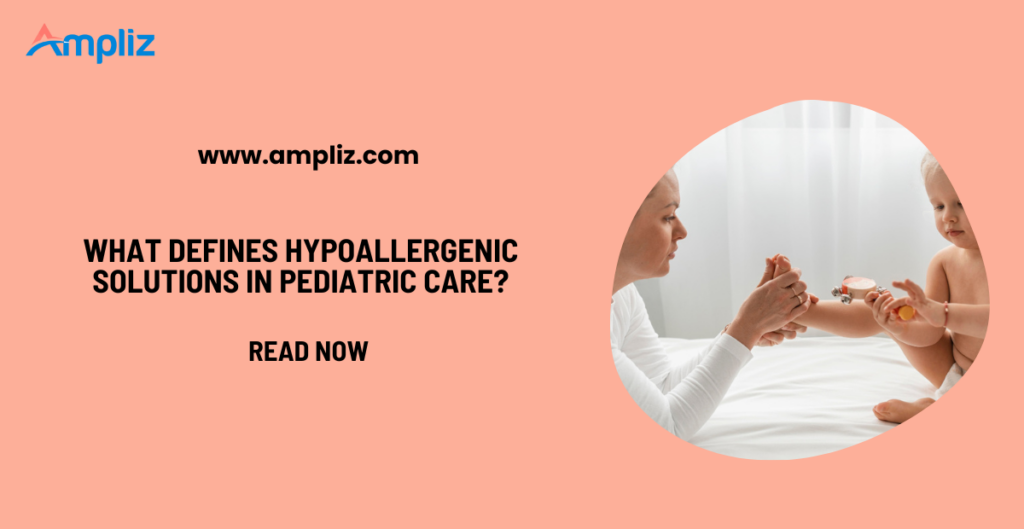Pediatric care extends from infants all the way to teenagers – and it includes determining how to handle unexpected health challenges along the way. With a rise in food allergies and other sensitivities, parents and health professionals are looking for safer products to give children in any context.
In particular, hypoallergenic solutions have emerged as a revolutionary option to minimize allergy irritations and exposure to harsh chemicals. Their positive impact is perhaps most notable in infant formula, as some standard varieties may increase the likelihood of certain allergies.
Keep reading to learn what hypoallergenic products are, and how they are helping today’s families make healthier decisions.
What Are Hypoallergenic Solutions?
When most people think of hypoallergenic, they think of allergies. In many products or foods, dyes, preservatives, or fragrances are among the ingredients that can trigger allergy problems in people of all ages.
But hypoallergenic products are formulated so that people may be less likely to experience an allergic reaction when using them. But that’s not all that these products can do, particularly as they relate to pediatric care.
For young children with sensitive immune systems, these products can help allergies appear less obvious within the body.
Some infants may come from families with a family history or allergy problems, meaning they are more likely to experience them, too. Consequently, hypoallergenic products are a helpful blockade against common allergens, like cow’s milk, to which a child is exposed in their first few years of life.
Hypoallergenic infant formulas rely on hydrolyzed proteins to help minimize the potential for sensitivities. Because these cow’s milk proteins are already broken down, they are easier for babies to digest.
By contrast, traditional formulas derived from cow’s milk are not made up of hydrolyzed proteins, so they are not as gentle on an infant’s stomach. For parents eager to provide nutritional value without the allergy risk, HiPP HA formulas are an excellent hypoallergenic choice.
Understanding the Science
Infants are more prone to developing allergies because their immune systems are not yet fully developed. The digestive tract linings are especially underdeveloped, meaning that allergens can be absorbed into the blood more easily.
In an allergic reaction, the immune system’s mast cells will release chemicals known as histamines. As a result, the person experiencing the allergic reaction will have responses like itching, sneezing, or hives.
For infants, hypoallergenic formulas are a way to avert significant allergic reactions. The smaller peptides within the formulas help ensure that the immune system doesn’t mistakenly see milk proteins as allergens. This means that an infant may not have to deal with skin rashes or other allergic reactions. And for parents, the extra peace of mind is invaluable.
Some hypoallergenic formulas also have ingredients that help formulate a better gut microbiome in infants, as well. The microbiome is also undergoing significant developments in an infant’s first several months of life.
It won’t be fully developed until a child turns three. So, fortifying a child’s gut with formula that contains prebiotics and probiotics is another way to support its healthy development and an infant’s ongoing health.
Knowing What Oversight Looks Like
Understandably, parents want the best for their children. And that mindset extends to the pediatric products they provide for the newest members of the family. Parents can rest assured that hypoallergenic formula is subject to strict regulations in the United States and abroad.
Formula labeled as hypoallergenic is bound to a testing protocol that affirms it meets quality standards and actually does help reduce allergy potential in infants.
Controlled trials and rigorous testing, according to European Food Safety Authority mandates, account for hypoallergenic formulas in the European Union. And in the United States, the Food and Drug Administration manages testing and regulations compliance for all infant formulas.
Meeting high standards for hypoallergenic formula is to a brand’s advantage for several reasons. It shows that formula manufacturers take their responsibilities and role in pediatric nutrition seriously. And this helps build trust and loyalty among customers.
So, it’s worth the time and investment in quality for manufacturers hoping to establish themselves in a competitive marketplace.
Considering Parents’ Values
Today’s infant formula manufacturers need to consider the bigger shift in values and preferences among parents. Parents have news reports and studies at their fingertips when they want to learn more about the latest pediatric products.
They can learn about lawsuits against formula manufacturers, for example, and read about other parents’ experiences simply by logging into a social media account.
As a result, today’s parents have higher standards, and hypoallergenic solutions tend to emerge as the best option in a crowded field.
Product manufacturers must demonstrate transparency through clinical trials and parent testimonials to earn parents’ approval, however. Products should list ingredients and explain clearly how they are better than their peers. And parents expect that ingredients will come from sustainable sources, like organic farms.
Further, they want to know that brands are working to reduce their carbon footprint and contribute to a better planet. In other words, today’s parents are more conscientious than ever, expecting brands to produce quality products that deliver on promises of reducing allergy risks while nourishing their children.
Focusing on the Benefits of Hypoallergenic Products
Although hypoallergenic products are best known for allergy mitigation, their benefits extend beyond this significant quality. They can offer nutritional value that can set the foundation for a healthy childhood. Anything from lung issues to GI problems can be lessened thanks to the fact that the hypoallergenic formula contains proteins that have already been broken down in size.
For instance, traditional infant formula derived from cow’s milk can cause issues like wheezing or coughing in some infants, or even asthma. It can also lead to gas or colic in infants, as well. Hypoallergenic formulas, on the other hand, build healthier digestion in infants and may even keep problems like eczema at bay.
When unsure, parents should consult a physician to determine the best course of action for a young child. In the end, though, when reaching for a hypoallergenic formula, parents can trust that they are giving their infant the best source of nutrition for their young body.
As researchers continue to refine approaches to creating hypoallergenic solutions, consumers have a lot to be excited about. Advanced engineering practices continue to push proteins closer to those found in breast milk, and some companies have even begun to tailor formulas to meet specific infant needs.
Continued research is enabling companies to look at DNA to assess allergy potential in infants, too, meaning that future developments will be even more precise.
Improving Pediatric Solutions
Parenthood comes with lots of anxiety, but the best hypoallergenic solutions can help parents feel more comfortable about what they’re giving their infant. And with concerns about allergies suddenly manifesting in their young children, hypoallergenic formulas may be the best choice for their needs.
Hypoallergenic products undergo rigorous testing to meet high safety standards, and a robust commitment to research in this area translates to continued dietary improvements. Companies manufacturing hypoallergenic infant formulas must be transparent to earn parents’ trust and meet high ethical standards.
Ultimately, hypoallergenic solutions in the area of infant formulas are the basis of a child’s healthy growth, and parents should feel entitled to ask for the best.



